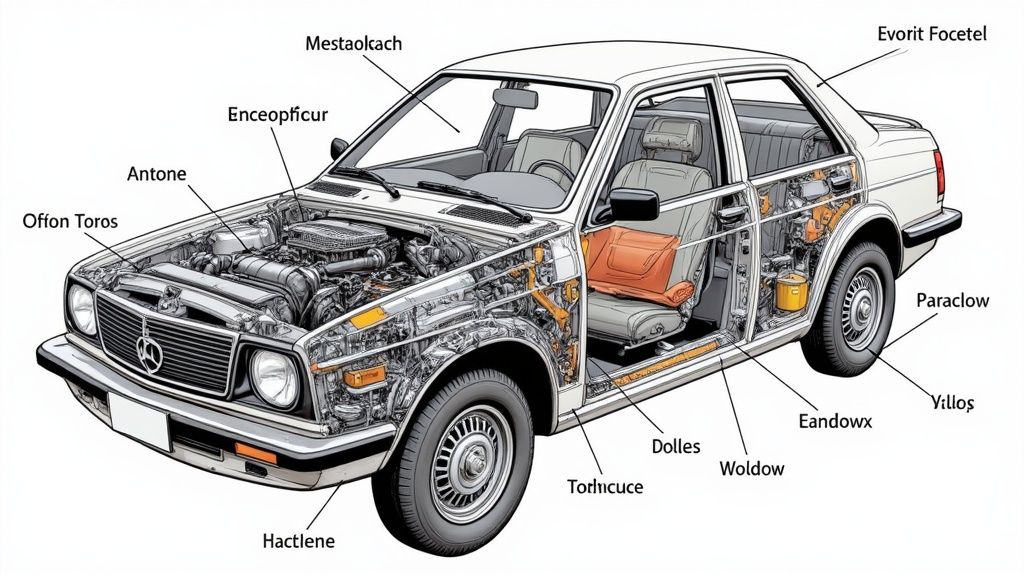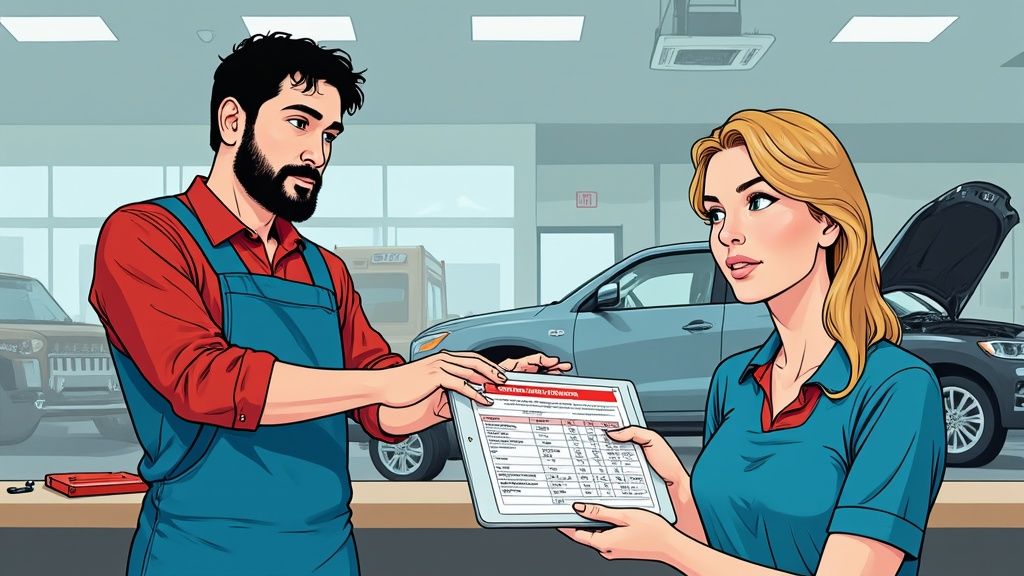
Auto Repair Labor Guide: Keys to Shop Success
Mastering Modern Auto Repair Labor Guides

Running a successful auto repair shop depends on providing accurate estimates and maintaining customer trust. Auto repair labor guides serve as essential tools that give standardized repair time estimates, directly impacting your pricing and shop profitability.
Why Labor Guides Matter
Auto labor guides establish consistency in repair time estimates for different vehicles and repairs. Consider two mechanics estimating an alternator replacement - without a guide, their estimates could vary significantly, leading to pricing inconsistencies. Labor guides provide standard repair times that ensure fair, uniform pricing that customers can trust.
Auto repair shops rely heavily on these guides for accurate timing and fair pricing. When replacing brake pads, a guide typically specifies 1.5 hours of labor. At a shop rate of $100 per hour, this creates a clear $150 labor charge. Modern digital guides connected to shop software make estimating even simpler and more precise. Learn more details at AutoLeap’s Labor Guide Overview.
Integrating Labor Guides into Your Workflow
Making labor guides work requires proper implementation in your daily operations. This means training technicians on consistent guide usage and connecting the data to your shop management system. Good integration creates smooth workflows from customer check-in through final billing.
Communicating Labor Costs to Customers
Open communication about costs builds customer confidence. Show customers how labor guides help set fair prices rather than arbitrary charges. Walk them through the guide’s estimated repair time and your shop’s hourly rate to demonstrate transparent pricing.
Choosing the Right Labor Guide
Select a labor guide that matches your shop’s needs. Key factors include the vehicle types you service, repair complexity levels, and guide detail. Look for comprehensive coverage and compatibility with your existing systems. The right guide streamlines estimates while improving overall shop efficiency.
Smart Pricing Across Regional Markets

Setting the right labor rates is essential for auto repair shop success. Your pricing needs to reflect your specific regional market conditions and account for key factors like local competition, cost of living, and state regulations.
Understanding Regional Variations
Let’s look at how auto repair labor rates vary across regions. For instance, California has relatively high rates, averaging $173 per hour, largely due to strict labor laws and elevated living costs. In contrast, states like Mississippi have notably lower rates matching their lower cost of living. Get more detailed data here: Average Automotive Repair Labor Rates by State.
Here’s a breakdown of typical labor rates by region:
| Region | Average Rate | Cost Factors |
|---|---|---|
| West Coast | $150-175/hr | High cost of living, strict regulations |
| Northeast | $125-150/hr | Dense competition, skilled labor costs |
| Midwest | $90-115/hr | Moderate living costs, fewer regulations |
| Southeast | $75-95/hr | Lower overhead, reduced living costs |
Strategic Pricing for Profitability
Your pricing strategy should consider more than just regional averages. Factor in your shop’s specific services and technician expertise. Shops in costlier areas often focus on specialized services and efficiency to justify higher rates. Even in lower-cost regions, positioning as a premium service provider can support better pricing.
Developing a Regional Pricing Strategy
To build an effective regional pricing approach:
- Research Local Market: Study competitor pricing in your area to identify gaps and opportunities
- Calculate Costs: Track all operating expenses including rent, utilities, and labor
- Define Value: Highlight what makes your shop unique, whether it’s expert technicians or fast service
Tailoring Services and Pricing
Use regional data to spot opportunities for specialized services that competitors might not offer. Consider creating tiered service packages to serve different customer segments in your market. Focus on matching your auto repair labor guide to local conditions while maintaining healthy profits.
For more information: Check our sitemap. The key is finding the right balance between competitive regional pricing and sustainable business operations.
Building a High-Performance Service Team

A strong team is the foundation of any successful auto repair shop. By investing in your technicians and fostering a positive work environment, you can significantly improve productivity and boost your shop’s bottom line.
Investing in Technician Growth
Expert technicians drive success in auto repair. Providing opportunities for professional development through specialized training and industry certifications helps your team stay current with evolving technology while increasing their value. Think of it as upgrading your most important tools - better skills lead to better results.
Regular training on new diagnostic tools and repair methods helps technicians work faster and more accurately. When technicians are well-trained, they can complete repairs within the labor guide timeframes, leading to better shop efficiency and higher customer satisfaction.
Implementing Effective Training Programs
Strong training programs should combine hands-on technical skills with proper use of labor guides. Focus on both current repair methods and emerging industry developments. Consistent labor guide usage ensures accurate estimates that build trust with customers.
Training should also develop communication abilities. When technicians can clearly explain repairs and costs to customers, it creates transparency and stronger relationships. Good communication is key to long-term customer loyalty.
Creating Career Advancement Paths
Keeping skilled technicians requires clear growth opportunities. Outline advancement paths that include increased responsibilities, specialized roles, and better earning potential. This gives your team goals to work toward while building loyalty.
The employment outlook shows 3% growth for auto technicians from 2023-2033. Current median pay is $47,770 annually, with top earners making over $77,630 according to Automotive Service Technicians and Mechanics. To attract and retain talent, competitive pay and benefits are essential.
Measuring Performance and Providing Feedback
Regular evaluations with constructive feedback help technicians improve and stay motivated. Track important metrics like:
- Repair completion times
- Customer satisfaction scores
- Additional service sales
This data helps identify strengths and areas needing improvement for both individuals and teams.
By prioritizing team development, auto repair shops create skilled technicians who use labor guides effectively while delivering excellent customer service. This investment drives both customer loyalty and shop success.
Making the Most of Digital Tools

Success in auto repair isn’t just about technical skills - it’s about using the right tools. More shops are now adopting digital auto repair labor guides to improve their workflow and accuracy. This shift from paper manuals represents a major step forward in repair shop operations.
Making the Switch to Digital Guides
While changing systems takes effort, digital labor guides offer clear benefits:
- Live Information: Digital guides update automatically with new repair procedures and times, ensuring your team always works with current data
- Works With Shop Software: Easy connection to your existing management systems means faster estimates and fewer data entry mistakes
- Better Precision: Digital tools reduce calculation errors, leading to more reliable estimates and better cost management
Getting Your Team Ready
For digital tools to work well, proper training is essential. Focus on teaching not just the software basics, but why consistent guide usage matters for accurate estimates. Show your team how to select vehicles correctly and find the right repair procedures. Regular practice sessions help reinforce good habits and address any questions.
Working With Your Current Systems
For best results, connect your digital labor guide to other shop tools like parts inventory and billing software. This creates a smooth process from estimate to final invoice. For example, completed repair times can automatically update customer bills, reducing manual work and mistakes. You might be interested in: Check our sitemap for further reading.
Real Results From Real Shops
Many shops report concrete improvements after going digital. One location saw a 15% boost in estimate accuracy, reducing billing disputes and improving customer satisfaction. Another achieved a 10% drop in office work through automated processes. These examples show the real value of digital tools.
Digital vs. Traditional Labor Guide Systems
Let’s compare key features between modern digital systems and traditional paper methods:
| Feature | Digital Systems | Traditional Methods |
|---|---|---|
| Accessibility | Instant access anywhere online | Must have physical book |
| Updates | Immediate automatic updates | Manual updates as needed |
| Accuracy | Fewer calculation errors | More room for mistakes |
| Integration | Works with other shop software | Standalone reference only |
| Efficiency | Fast automated workflow | Manual lookup and entry |
By using digital solutions effectively, auto repair shops can work more efficiently, provide more accurate service, and build better customer relationships. These tools help shops deliver reliable service in a competitive industry.
Maximizing Shop Profits Through Smart Planning
A solid auto repair labor guide is essential but just the start of building a profitable shop. Success comes from thoughtfully blending labor guides with effective pricing, technician management, and customer service that clients value. This thoughtful approach helps create lasting customer relationships and steady income.
Optimizing Your Pricing Structure
Your shop’s hourly labor rate must cover key expenses like rent, utilities, and staff wages while generating adequate profit. But a higher rate alone isn’t enough - you need to show customers why your services merit your pricing through exceptional value.
Show clients how investments in specialized training and quality diagnostic tools justify your rates. Open communication about how your labor guide shapes estimates helps build trust and reduce price concerns.
Managing Technician Productivity
Your technicians directly impact your success. Having standardized repair times through a detailed auto repair labor guide helps them work systematically and efficiently. This eliminates time wasted searching for information or revising estimates.
Regular training keeps your team current on new vehicle technologies and repair methods. When technicians can complete work efficiently within labor guide timeframes, it boosts overall shop performance and profit.
Building Value-Based Service Packages
Service packages combining related repairs and maintenance tasks benefit both customers and shops. Customers appreciate simplified pricing and shops can better predict revenue.
For instance, a “Brake Service Package” might bundle pad replacement with rotor resurfacing and fluid checks. This gives customers more complete service while increasing your per-vehicle revenue.
Implementing Effective Upselling Strategies
Smart upselling focuses on educating customers about preventive maintenance tailored to their vehicle’s needs. Service advisors can reference the auto repair labor guide to clearly explain recommended services and their costs.
This positions your shop as a trusted maintenance partner rather than just a repair stop. Learn more in our article about How to master your shop management. When done properly, proactive service recommendations improve both customer satisfaction and shop profits.
Creating Pricing Models for Long-Term Growth
Keep your pricing model flexible to adjust for market changes and customer needs. Review your labor guide and rates regularly to stay competitive while maintaining profits. Consider offering different service tiers or expertise-based pricing.
This adaptable strategy helps you serve diverse customer groups while rewarding those who choose premium services. The right mix of accurate labor guides, skilled technicians, and customer-focused service builds lasting success.
Implementation Strategies That Drive Success
Getting the most from an auto repair labor guide requires proper planning, detailed training, and ongoing review. Here’s how to successfully integrate this essential tool into your shop’s operations.
Introducing New Systems Effectively
When adding new software, clear communication is crucial. Explain to your team exactly how the labor guide will help them work more efficiently and provide better service to customers. Show specific examples of how it streamlines estimates and helps price unusual repairs fairly.
Focus initial training sessions on the core features that technicians will use daily. Walk through real repair scenarios together to build comfort with the system. This hands-on approach helps staff understand the practical benefits.
Training Your Team for Success
A thorough training program is essential. Schedule dedicated practice time where technicians can work with the guide using actual repair examples. Answer questions directly and encourage discussion about how to handle different situations.
Create simple reference materials like quick-start guides and common task checklists. Having these resources readily available helps reinforce training and ensures consistent usage across the shop.
Avoiding Common Implementation Pitfalls
Many shops make the mistake of inadequate training, leaving staff to figure out the system on their own. This leads to inconsistent use and missed opportunities. Regular refresher sessions keep everyone up to date on best practices.
Another error is keeping the labor guide separate from other shop systems. This creates extra work and increases errors. Connect your guide with your existing management software to streamline operations.
Maintaining Consistency and Adaptability
While consistent pricing is important, your rates should evolve with market conditions. Review your auto repair labor guide regularly to ensure your pricing matches local competition and demand for specific services.
For instance, you may need to adjust labor rates up when demand spikes for certain repairs. Or you might lower rates temporarily in response to increased local competition.
Tracking Success with Performance Metrics
Monitor key data points to measure how well your labor guide implementation is working:
- Estimate Accuracy: Compare predicted vs actual repair times
- Technician Efficiency: Track completion times against guide estimates
- Customer Satisfaction: Review feedback on pricing transparency
This information shows exactly how the guide impacts your operations. Regular analysis helps identify areas for improvement and refine your pricing strategy.
Keep detailed records of rates, repair times, and costs. This data helps spot trends and justify prices to customers. For comprehensive maintenance tracking and reporting, consider Auto Service Logger. It provides a central platform for managing service records and analyzing shop performance.